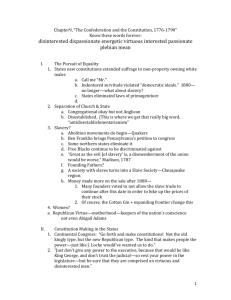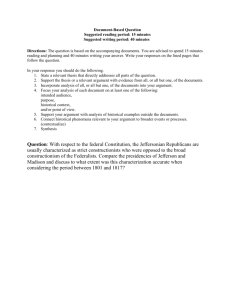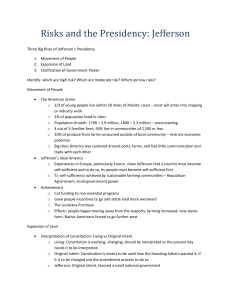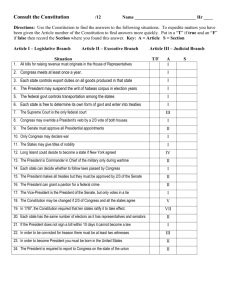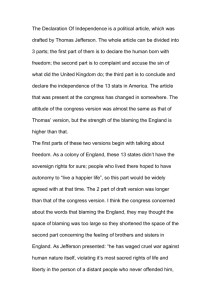Building a Nation
advertisement
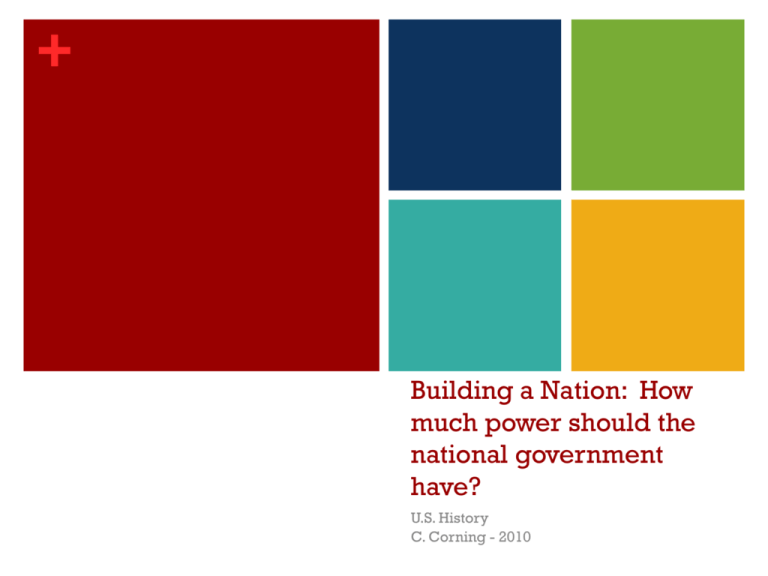
+ Building a Nation: How much power should the national government have? U.S. History C. Corning - 2010 + See Think Wonder http://www.earlyamerica.com/earlyamerica/firsts/cartoon/s nake.html SEE / THINK / WONDER Question: What was Franklin’s purpose in creating this cartoon in 1754? Why do you think it was used again during the American Revolution? + Forming a National Government Articles of Confederation – 1777 Continental Congress sent the A of C to the colonies for ratification. Concerns: Strong national government and unequal power between states Limitations: National government had no power to tax or regulate trade Amendments required unanimous consent of all states Other problems: Wartime gov’t had to print money to pay for war – inflation British punished colonies by restricting trade with West Indies Economic sectionalism – South more vulnerable – cash crops Britain refused to abandon military posts in States – loyalists Shay’s Rebellion – 1787 – famers protest unfair political and economic policies – resentment between backcountry farmers and coastal elite. + Articles of Confederation What was working well? Government won the American Revolutionary War Northwest Ordinance 1787 – governing sale of government lands to settlers Included a bill of rights guaranteeing trial by jury, freedom of religion, freedom from excessive punishment Also abolished slavery from NW territories (NW of the Ohio River and east of the Mississippi River, up to Canadian border) Regulations concerning the conditions under which territories could apply for statehood. Read Articles – page 56 in “We the People” packet What were the advantages/disadvantages for the states and/or national government? + Articles of Confederation – Weaknesses Congress had no power to tax – could only ASK for money No power over the state governments and their citizens – citizens could only be governed by THEIR states’ laws. Unenforceable trade agreements – Congress could make trade agreements but could not force the States to abide by them. Unfair competition among the States – Congress had no power to regulate taxes among the States. Failed to protect citizens’ right to property. Failed to protect the rights of the minority (vs majority rule) + Constitutional Convention – Philadelphia 1787 Who: 55 delegates, all men, white, many of whom were wealthy lawyers and landowners, many of who also owned slaves. Some wanted to revise the A of C (New Jersey Plan) – others wanted a new constitution. James Madison – before convention he had drafted a plan for a new government – Virginia Plan Proposed a strong national government with the power to make and enforce its own laws, and to collect its own taxes. Each citizen would be governed under the authority of two (later three) governments – National, State (and Local). Both govts get their authority from the consent of the governed. Both national and state govts are given a certain amount of authority – federalism. + Virginia Plan – more details! Three branches of national government: The national legislature – Congress – was to have two houses. Legislative – to be the most powerful because it had the power to select people to serve in executive and judicial branches Executive Judicial House of Representatives – directly elected by the people of each state. Senate – elected by the members of the House of Reps Proportional representation – based on size of state’s population or contribution to federal treasury. + New Jersey Plan Also known as the “Small States Plan” because smaller states were concerned about a strong national govt. Wanted to keep the framework of the A of C. NJ Plan: Legislature: Congress would only have one house and it would have increased powers: Power to levy import duties and stamp tax, and power to collect money from states Regulate trade among the states and with other nations Control over the states – any law made by Congress would be “law of the land” – states couldn’t make laws contrary to them. Executive: Several people appted by Congress – administer national laws, appoint executive officials and control military. Judicial: Supreme Court appointed by officials of executive branch. + Constitutional Convention Problems All the delegates agreed that the A of C were not working – however the resolution process was not easy. Two large issues caused conflict: Great Compromise – blended the VA and NJ plans How should the number of representatives from each state be determined? According to population? Equal vote? What powers should the national government have? House of Reps – based on population of each states Senate – equal representation for each state (two each) H of Rep have power to tax and spend govt money U.S. Constitution (1787 / ratified 1789 / Bill of Rights – 1791) + U.S. Constitution - Highlights Bicameral Legislature Lower House – House of Representatives elected by the people Upper House – Senate elected by the state legislatures (direct elections not until 20th century) Executive – President and Vice President to be elected by Electoral College, not directly by citizens themselves 3/5 Compromise – slaves to be counted as 3/5 of a person when determining the population of a state and how much representation the state would have in Congress Established three branches of government – with the power of check and balances on each other. + Ratification Process Once the Constitutional Convention was complete, the new constitution had to be ratified. What were the issues? (see pages 84 – 90 “We the People” packet) Anti-Federalists – concern over strong national government, tended to come from the backcountry and were concerned about the absence of a Bill of Rights. Federalists – argue for the values of a strong national government. The Federalist Papers – essays defending the new constitution, authored by James Madison, Alexander Hamiiton and John Jay. Published in New York newspapers. + The Washington Presidency: 1789 – 1797 The Electoral College unanimously chose George Washington to be the first president. Washington knew his presidency would set a precedent for future administrations: Cautious in his use of executive power Created a cabinet to advise him – not part of Constitution but every president has had one. Did not want to be a “king” – no bowing, titles, etc. Important Cabinet members: Thomas Jefferson – Secretary of State (States rights) Alexander Hamilton – Secretary of Treasury (Strong central govt) These two disagreed about the creation of a National Bank and support for the French Revolution – origins of our two-party system Federalists vs. Democratic-Republicans Caused concern because people saw these as factions who only were concerned about their own interests (hmm, sound familiar?) Read pages 102 – 106 “We the People” packet. + The Adams Presidency: 1797 – 1801(Federalist) John Adams was one of our founding fathers – he had served as a Congressional representative to European countries, secured loans from Amsterdam bankers to pay for the war and concluded the Treaty of Paris with Great Britain. The second-place candidate was Thomas Jefferson and he became VP (but opposing political party – any problems with that?) Achievements: Avoided war with France Disappointments: Alien and Sedition Acts which allowed govt to expel foreigners (vs immigrants??) and jail newspaper editors for “malicious” writing (what happened to the 1st Amendment?) who were mainly Demo-Reps. + The Jeffersonian Presidency: 1801 – 1809 (Democratic-Rep.) Started with the “Revolution of 1800” – meaning a bloodless transfer of power from one political party (Federalists) to another (Demo-Rep). In addition to writing the Declaration of Independence, Jefferson also served as Governor of Virginia, Minister to France, member of the Congress of Confederation, Secretary of State under Washington. Adams was upset that the Federalists were out of power and made “midnight appointments” filling many of the national govt positions with Federalists as possible. Jefferson refused to recognize these appointments – Marbury vs. Madison (judicial review- responsibility for reviewing the constitutionality of Congressional acts.) Repealed Alien and Sedition Acts Jefferson wanted to reduce the national debt (a bit ironic considering his own personal financial situation) + Louisiana Purchase - 1803 In 1800 Spain gave New Orleans to the French – which had given it to the Spanish in 1762 after the French-Indian War This might threaten US trade down the Mississippi River. Jefferson wanted to purchase New Orleans and western Florida from France. Napoleon had given up on his dreams of American empire and was in the mood to sell the entire Louisiana Territory for $15 million. The size of the US had doubled. Lewis and Clark Expedition – Jefferson sent Corps of Discovery to explore the new holdings – 2.4 years – from city of St. Louis to the Pacific (see page 200 in textbook) Merriwether Lewis and William Clark Sacajawea – interpreter and guide + Jefferson’s Second Term / Madison 1809 - 1817 Embargo 1807 – British had tried to place on blockade on France and caught approx. 1000 American ships and “impressed” the Americans into service in British navy. Congress declared an embargo – a ban on exporting products to other countries – against Great Britain. War of 1812 – Madison declares war against Great Britain (see page 204 in textbook) because he felt that it was trying to destroy the American economy. Native Americans aligned with the British, American troops illprepared 1814 – British burn the White House Treaty of Ghent – 1814 – a general armistice, over the following years the two countries reached agreements on many trade and diplomatic issues. Positive Outcome: Increased American manufacturing – WHY?


